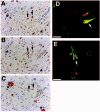The p53 homologue p73 accumulates in the nucleus and localizes to neurites and neurofibrillary tangles in Alzheimer disease brain
- PMID: 14720173
- PMCID: PMC1540445
- DOI: 10.1046/j.0305-1846.2003.00496.x
The p53 homologue p73 accumulates in the nucleus and localizes to neurites and neurofibrillary tangles in Alzheimer disease brain
Abstract
The molecular mechanisms that regulate neuronal survival vs. death during Alzheimer disease (AD) remain unclear. Nonetheless, a number of recent studies indicate that increased expression or altered subcellular distribution of numerous cell cycle proteins during AD may contribute to disease pathogenesis. Because homologues of p53, a key regulatory protein in the cell cycle, such as p73, have been identified and shown to participate in cellular differentiation and death pathways, we examined the expression and distribution of p73 in the hippocampus of eight control and 16 AD subjects. In control subjects, hippocampal pyramidal neurones exhibit p73 immunoreactivity that is distributed predominately in the cytoplasm. In AD hippocampus, increased levels of p73 are located in the nucleus of pyramidal neurones and p73 is located in dystrophic neurites and cytoskeletal pathology. Immunoblot analysis confirmed the presence of p73 in the hippocampus. These data indicate that p73 is expressed within hippocampal pyramidal neurones and exhibits altered subcellular distribution in AD.
Figures




Similar articles
-
Subcellular distribution of p53 and p73 are differentially regulated by MDM2.Cancer Res. 2001 Sep 15;61(18):6703-7. Cancer Res. 2001. PMID: 11559539
-
Increased p27, an essential component of cell cycle control, in Alzheimer's disease.Aging Cell. 2003 Apr;2(2):105-10. doi: 10.1046/j.1474-9728.2003.00042.x. Aging Cell. 2003. PMID: 12882323
-
Differential response of p53 target genes to p73 overexpression in SH-SY5Y neuroblastoma cell line.J Cell Sci. 2004 Jan 15;117(Pt 2):293-301. doi: 10.1242/jcs.00834. J Cell Sci. 2004. PMID: 14676279
-
Negative autoregulation of p73 and p53 by DeltaNp73 in regulating differentiation and survival of human neuroblastoma cells.Cancer Lett. 2003 Jul 18;197(1-2):105-9. doi: 10.1016/s0304-3835(03)00090-9. Cancer Lett. 2003. PMID: 12880968 Review.
-
Structure and apoptotic function of p73.BMB Rep. 2015 Feb;48(2):81-90. doi: 10.5483/bmbrep.2015.48.2.255. BMB Rep. 2015. PMID: 25441426 Free PMC article. Review.
Cited by
-
Analysis of the intracellular localization of p73 N-terminal protein isoforms TAp73 and ∆Np73 in medulloblastoma cell lines.J Mol Histol. 2010 Oct;41(4-5):267-75. doi: 10.1007/s10735-010-9288-0. Epub 2010 Aug 28. J Mol Histol. 2010. PMID: 20803057
-
p53 prevents neurodegeneration by regulating synaptic genes.Proc Natl Acad Sci U S A. 2014 Dec 16;111(50):18055-60. doi: 10.1073/pnas.1419083111. Epub 2014 Dec 1. Proc Natl Acad Sci U S A. 2014. PMID: 25453105 Free PMC article.
-
UBE4B: a promising regulatory molecule in neuronal death and survival.Int J Mol Sci. 2012 Dec 10;13(12):16865-79. doi: 10.3390/ijms131216865. Int J Mol Sci. 2012. PMID: 23222733 Free PMC article. Review.
-
Cooperative role of RanBP9 and P73 in mitochondria-mediated apoptosis.Cell Death Dis. 2013 Jan 24;4(1):e476. doi: 10.1038/cddis.2012.203. Cell Death Dis. 2013. PMID: 23348590 Free PMC article.
-
Complex regulation of p73 isoforms after alteration of amyloid precursor polypeptide (APP) function and DNA damage in neurons.J Biol Chem. 2011 Dec 16;286(50):43013-25. doi: 10.1074/jbc.M111.261271. Epub 2011 Oct 14. J Biol Chem. 2011. PMID: 22002055 Free PMC article.
References
-
- Lyras L, Cairns N, Jenner A, Jenner P, Halliwell B. An assessment of oxidative damage to proteins, lipids, and DNA in brain from patients with Alzheimer's disease. J Neurochem. 1997;63:2061–9. - PubMed
-
- Smith MA, Rottkamp CA, Nunomura A, Raina AK, Perry G. Oxidative stress in Alzheimer's disease. Biochim Biophys Acta. 2000;1502:139–44. - PubMed
-
- Smith MA, Sayre LM, Anderson VE, Beal MF, Kowall N, Richey PL, Perry G. Oxidative damage in Alzheimer's disease. Nature. 1996;382:120–1. - PubMed
-
- Bennett M, Macdonald K, Chan S-W, Luzio JP, Simari R, Weissberg P. Cell surface trafficking of Fas. A rapid mechanism of p53-mediated apoptosis. Science. 1998;282:290–3. - PubMed
-
- De Laurenzi V, Melino G. Evolution of functions within the p53/p63/p73 family. Ann NY Acad Sci. 2000;926:90–100. - PubMed
Publication types
MeSH terms
Substances
Grants and funding
LinkOut - more resources
Full Text Sources
Medical
Research Materials
Miscellaneous

